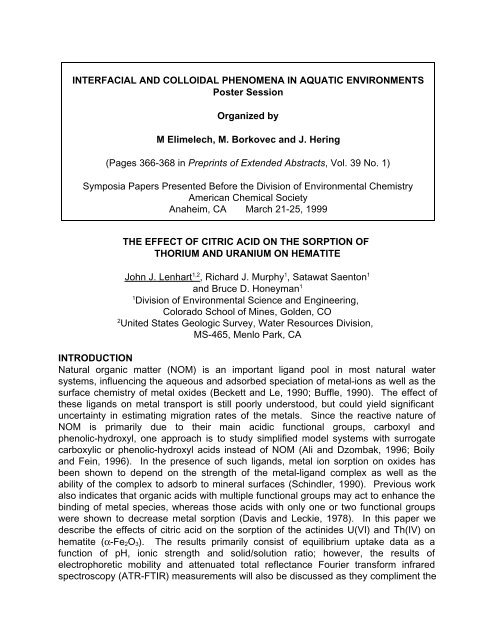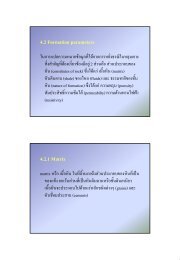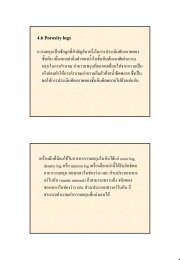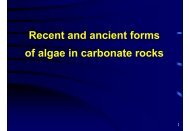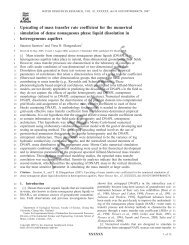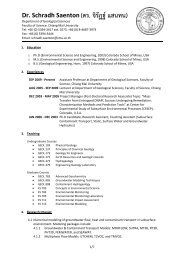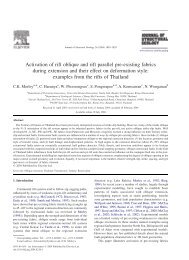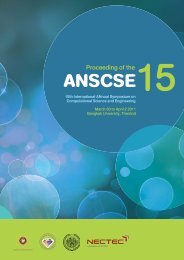THE EFFECT OF CITRIC ACID ON THE SORPTION OF THORIUM ...
THE EFFECT OF CITRIC ACID ON THE SORPTION OF THORIUM ...
THE EFFECT OF CITRIC ACID ON THE SORPTION OF THORIUM ...
You also want an ePaper? Increase the reach of your titles
YUMPU automatically turns print PDFs into web optimized ePapers that Google loves.
INTERFACIAL AND COLLOIDAL PHENOMENA IN AQUATIC ENVIR<strong>ON</strong>MENTSPoster SessionOrganized byM Elimelech, M. Borkovec and J. Hering(Pages 366-368 in Preprints of Extended Abstracts, Vol. 39 No. 1)Symposia Papers Presented Before the Division of Environmental ChemistryAmerican Chemical SocietyAnaheim, CA March 21-25, 1999<strong>THE</strong> <strong>EFFECT</strong> <strong>OF</strong> <strong>CITRIC</strong> <strong>ACID</strong> <strong>ON</strong> <strong>THE</strong> SORPTI<strong>ON</strong> <strong>OF</strong><strong>THORIUM</strong> AND URANIUM <strong>ON</strong> HEMATITEJohn J. Lenhart 1,2 , Richard J. Murphy 1 , Satawat Saenton 1and Bruce D. Honeyman 11Division of Environmental Science and Engineering,Colorado School of Mines, Golden, CO2United States Geologic Survey, Water Resources Division,MS-465, Menlo Park, CAINTRODUCTI<strong>ON</strong>Natural organic matter (NOM) is an important ligand pool in most natural watersystems, influencing the aqueous and adsorbed speciation of metal-ions as well as thesurface chemistry of metal oxides (Beckett and Le, 1990; Buffle, 1990). The effect ofthese ligands on metal transport is still poorly understood, but could yield significantuncertainty in estimating migration rates of the metals. Since the reactive nature ofNOM is primarily due to their main acidic functional groups, carboxyl andphenolic-hydroxyl, one approach is to study simplified model systems with surrogatecarboxylic or phenolic-hydroxyl acids instead of NOM (Ali and Dzombak, 1996; Boilyand Fein, 1996). In the presence of such ligands, metal ion sorption on oxides hasbeen shown to depend on the strength of the metal-ligand complex as well as theability of the complex to adsorb to mineral surfaces (Schindler, 1990). Previous workalso indicates that organic acids with multiple functional groups may act to enhance thebinding of metal species, whereas those acids with only one or two functional groupswere shown to decrease metal sorption (Davis and Leckie, 1978). In this paper wedescribe the effects of citric acid on the sorption of the actinides U(VI) and Th(IV) onhematite (α-Fe 2 O 3 ). The results primarily consist of equilibrium uptake data as afunction of pH, ionic strength and solid/solution ratio; however, the results ofelectrophoretic mobility and attenuated total reflectance Fourier transform infraredspectroscopy (ATR-FTIR) measurements will also be discussed as they compliment the
atch results. Finally, the application of surface complexation modeling techniques tothese systems will also be discussed.MATERIALSThe majority of thorium employed in the Th/COM system was 232 Th as Th(NO 3 ) 4 ,obtained from Johnson Matthey. Thorium-234, separated from uranyl acetate by ionexchange, was employed as a tracer and was measured using liquid scintillationcounting (LSC). In the same manner, the bulk of the uranium used in the experimentsis natural uranium, as uranyl nitrate, UO 2 (NO 3 ) 2 , purchased from AndersonLaboratories, Inc. To facilitate analysis by LSC, samples were spiked with 233 Upurchased from Isotope Products Laboratory. Stock solutions of each isotope wereprepared in acid (HNO 3 or HCl) and subsequently added as needed to each sample toprovide the required total actinide concentrations (10 -9 M Th T and 10 -6 M U T ). A stocksolution of 1.00 M citric acid was prepared and standardized potentiometrically.Carbon-14 labeled citric acid supplied by Sigma was used to supplement unlabeledcitric acid allowing for analysis using LSC.The hematite used in these experiments is the same as used by Murphy et al.(1998a,b) and Lenhart and Honeyman (1998). It was synthesized by adding 50 ml of0.72 M FeCl 3 (in 0.001 M HCl) to 1950 ml boiling 0.004 M HCl after Penners andKoopal (1986). This solution was heated in an oven at 100°C for 24 hours, after whichtime it was rapidly cooled to room temperature. The hematite sol was cleaned toremove amorphous phases by rinsing with 0.001 M HClO 4 , followed by centrifugation toseparate the hematite. The particles were confirmed to be monodisperse spheresusing scanning electron microscopy. The specific surface area was determined usingthe average particle diameter of 66 nm measured by dynamic light scattering (Lenhartand Honeyman, 1998). The pH ppzc of 9.25 was determined based on the commonintersection of potentiometric titration data at different ionic strengths (Lenhart andHoneyman, 1998; Murphy et al., 1998a). A surface site density of 2.31 sites/nm 2 wasused following the arguments of Davis and Kent (1990).METHODSBatch sorption experiments were conducted by adding aliquots of the stock hematitesol to 50 ml polycarbonate Oakridge centrifuge tubes. Sufficient NaClO 4 was added tobring the ionic strength to the desired value. For experiments at pH values greaterthan 6, aliquots of NaHCO 3 were added to facilitate solution equilibration withatmospheric CO 2 after Waite et al. (1994). The hematite solution at the desired ionicstrength was allowed to equilibrate overnight to eliminate pH-drift. The lids for thetubes had small holes drilled in them to aid in maintaining system equilibrium withambient levels of CO 2 .After pre-equilibration, aliquots of uranium, thorium and/or citric acid were added toprovide the required total uranium, thorium or citric acid concentration(s) (U(VI) T ,Th(IV) T and Cit T ). The pH of the samples was adjusted with NaOH or HCl and sufficientnanopure water was added to bring all samples to the same volume. The samples
were then placed on a shaker table in the dark to eliminate effects due to UV-light andallowed to equilibrate. After equilibration, the final sample pH was recorded and thesolids were separated by centrifugation. The dissolved uranium, thorium or citric acidconcentration in the supernatant was determined by scintillation counting of the 233 U,234Th or 14 C-citric acid with a Packard 2500TR liquid scintillation analyzer. The fractionsorbed was calculated by subtracting the measured final aqueous concentrations fromidentical samples prepared without hematite.RESULTSFigure 1 shows the results from Lenhart and Honeyman (1998) for U(VI) sorption as afunction of pH at hematite concentrations of 0.09, 0.9 and 9.0 g/l, at an ionic strength of0.1. In the presence of carbonate, and in the alkaline pH region, U(VI) has been shownto primarily exist in the form of weakly-sorbing uranyl-carbonato solution phasecomplexes leading to the “anion-like” desorption edge (Waite et al., 1994). Using the0.9 g/l data as a baseline, an increase in hematite mass concentration to 9.0 g/l shiftsthe sorption envelope to lower pH values in the ‘cation-like’ region of the sorptionenvelope and to higher pH values in the ‘anion-like’ region. As expected, a decrease inthe hematite concentration to 0.09 g/l from 0.9 g/l shrinks the sorption envelope andmaximum uptake is less than 100% as the available hematite surface sites approachsaturation.In a similar fashion the sorption of Th(IV) to hematite was examined over a pH range of~1 to 12. Experiments were performed over a wide range of solid/solution ratios(Th(IV) T from 10 -14 M to 10 -9 M and hematite from 0.1 g/l to 10g/l). Shown in Figure 2are the results of 10 -9 M Th(IV) sorbing to hematite at 0.1 and 1.0 g/l (I = 0.1). Thesteep sorption edge in the low pH region indicates a relatively strong actinide/surfacesite complex. The location and slope of this edge in the ‘cation-like’ region isconsistent with all of the sorption edges generated over the entire range of Th/hematiteratios examined. At hematite concentrations greater than 0.1 g/l the Th(IV) remainssorbed to the surface over all pH values of approximately 3 and greater. On examiningthe alkaline region of the 0.1 g/l hematite sorption edge, solution phasethorium-carbonato species may be the root cause of the desorption seen at pH valuesgreater than 8. This process is currently under examination.
Fraction U(VI) T Sorbed1.00.90.80.70.60.50.40.30.20.19 g/l hematite0.9 g/l hematite0.09 g/l hematite0.02 3 4 5 6 7 8 9 10 11pHFraction Th(IV) T Sorbed1.00.90.80.70.60.50.40.30.20.11.0 g/l hematite0.1 g/l hematite0.00 2 4 6 8 10 12pHFigure 1. U sorption to hematite as afunction of solid/solution ratio at I = 0.1and U(VI) T = 10 -6 M (Lenhart andHoneyman, 1998).Figure 2. Thorium sorption to hematiteas a function of solid/solution ratio atI = 0.1 and Th(IV) T = 10 -9 M (Murphyet al., 1998b).The sorption of citric acid by hematite was studied over a range of pH values as afunction of total citric acid, Cit T . As shown in Figure 3, citric acid sorption (I = 0.1)increases as the pH decreases and levels off at a pH near 6. These results arerepresentative of carboxylic organic acids (Evanko and Dzombak, 1998) and are similarto those previously observed for citric acid sorption onto goethite (e.g., Redden et al.,1998). An increase in the citric acid concentration from 10 -6 to 10 -5 M results in a slightshift in the edge to lower pH values, with no change in the maximum fraction sorbed.However, a further increase in Cit T to 5 x 10 -5 M not only further shifts the edge to lowerpH values but also results in a maximum uptake of 68% versus 100% for the othersystems. This result indicates that the available hematite surface sites are nearingsaturation with respect to citrate.Figure 4 summarizes the results for U(VI) sorption onto 0.9 g/l hematite in the presenceof increasing concentrations of citric acid at I = 0.1. As the total concentration of citricacid increases, the “cation-like” portion of the adsorption edge gradually shifts to lowerpH values, indicating enhanced U(VI) sorption. The effect of citric acid is leastnoticeable at equimolar concentrations of uranium and citric acid and most noticeableat a ratio of U(VI) T : Cit T of 1:50. In fact, at this highest ratio of citrate to uranium, thesorption of U exhibits an initial maximum of ~ 65% removed at a pH of 4, followed by adecrease in sorption to ~ 45% removed at pH 5 after which sorption increases to 100%at a pH of 7. Although presently unconfirmed, a likely cause of the complex sorptionbehavior at low pH values in systems with high citrate concentrations is from thesorption of a ternary uranyl-citrate-hematite complex, followed by the desorption of theuranyl-citrate complex. The “anion-like” portion of the edge is essentially unchanged inthe presence of citric acid, as the uranyl-carbonato complexes become the dominant
uranium species at pH values greater than 7 in the presence of atmosphericconcentrations of carbonate.1.00.90.90.80.8Fraction Cit T Sorbed0.70.60.50.40.30.20.001 mM Citrate0.01 mM Citrate0.05 mM CitrateFraction U(VI) T Sorbed0.70.60.50.40.30.2No Citrate0.001 mM Citrate0.01 mM Citrate0.05 mM Citrate0.10.10.02 3 4 5 6 7 8 9 10pH0.02 3 4 5 6 7 8 9 10pHFigure 3. Citric acid sorption to hematite Figure 4. U sorption to hematite in theas a function of solid/solution ratio at presence of citric acid at U(VI) T = 10 -6 M,I = 0.1 and 0.9 g/l hematite.I = 0.1 and 0.9 g/l hematite.The sorption of thorium to hematite (0.1 and 1.0 g/l) is being examined in the presenceof varied citric acid concentrations (10 -6 M to 10 -3 M) at an ionic strength of 0.1. Thesorption of nanomolar Th(IV) onto 1g/l hematite in the presence of citric acid at 10 -3 Mand 10 -6 M and in the absence of the ligand is shown in Figure 5. There does notappear to be an effect by micromolar citric acid on the sorption of thorium to hematite atthese solution conditions. The impact of 10 -3 M citric acid is much more complex. AtpH values of 2 and less the acid enhances the sorption of Th(IV) to hematite, betweenpH values of 2 and 3 the citric acid does not appear to have an impact. In the pH rangeof 3 to 8 the thorium sorption is similar to that observed in the uranium system, with Thsorption decreasing after the initial maximum at pH 3 to ~ 40% removed at pH 5.5.This “minimum” is followed by readsorption of Th until 100% is removed at pH 7.5. Wepropose that the formation of solution phase thorium-citrate complexes is responsiblefor this behavior. Additional experiments with citric acid concentrations between 10 -6and 10 -3 provide a series of sorption edges showing a trend between the boundingconcentrations.Surface complexation models for U(VI) sorption and Th(IV) sorption have beendeveloped in our previous work (Lenhart and Honeyman, 1998; Murphy et al., 1998b).However, the model for citric acid sorption is still in development and electrophoreticmobility and Fourier tranform infrared (FTIR) experiments are being conducted toconstrain the possible modeling choices. Preliminary results of electrophoretic mobilitymeasurements collected at the same solid/solution ratios for citric acid sorption show asignificant decrease in the hematite surface charge, perhaps indicating a
ligand-exchange mechanism. Only after all binary systems are described will it bepossible to simulate the ternary systems shown in Figures 4 and 5.1.00.9Fraction Th(IV) T Sorbed0.80.70.60.50.40.30.20.1No Citrate0.001 mM Citrate1.0 mM Citrate0.00 2 4 6 8 10 12pHFigure 5. Th sorption to hematite in the presence of citric acid at Th(IV) T = 10 -9 M, I =0.1 and 1.0 g/l hematite (Murphy et al., 1998b).ReferencesAli M. A. and Dzombak D. A. (1996) Geochimica et Cosmochimica Acta 60(2), 291-304.Beckett R. and Le N. P. (1990) Colloids and Surfaces 44, 35-49.Boily J.-F. and Fein J. B. (1996) Geochimica et Cosmochimica Acta 60(16), 2929-2938.Buffle J. (1990) Complexation Reactions in Aquatic Systems. Ellis Horwood.Davis J. A. and Kent D. B. (1990) In Mineral-Water Interface Geochemistry, Vol. 23(ed. M. F. Hochella, Jr. and A. F. White), pp. 177-260. Mineralogical Society ofAmerica.Davis J. A. and Leckie J. O. (1978) Environmental Science and Technology 12(12),1309-1315.Evanko C. R. and Dzombak D. A. (1998) Environmental Science and Technology32(19), 2846-2855.Lenhart J. J. and Honeyman B. D. (1998) Submitted to Geochimica et CosmochimicaActa.Murphy R. J., Lenhart J. J., and Honeyman B. D. (1998a) Accepted by Colloids andSurfaces A.Murphy, R. J., Lenhart, J. J., Satawat, S., and Honeyman, B. D. (1998b) Manuscript inPreparation.Penners N. H. G. and Koopal L. K. (1986) Colloids and Surfaces 19, 337-349.Redden G. D., Li J., and Leckie J. (1998) In Adsorption of Metals by Geomedia (ed. E.A. Jenne). Academic Press.Schindler P. W. (1990) In Mineral-Water Interface Geochemistry, Vol. 23 (ed. MichaelF. Hochella Jr. and A. F. White). Mineralogical Society of America.Waite T. D., Davis J. A., Payne T. E., Waychunas G. A., and Xu N. (1994) Geochimicaet Cosmochimica Acta 58(24), 5465-5478.


